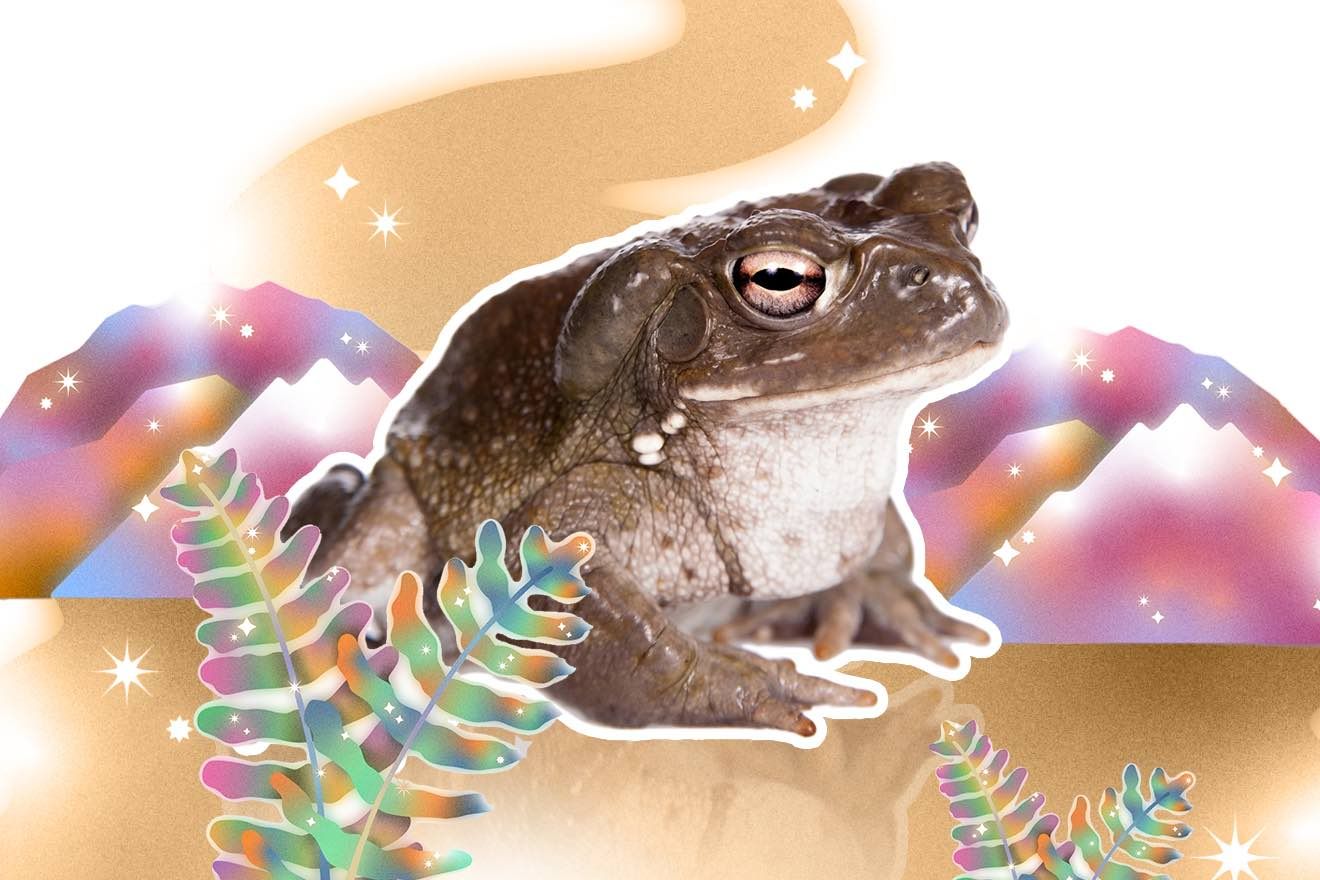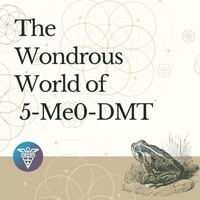5-MeO-DMT is less commonly known compared to psilocybin and LSD. But recently it has been gaining more attention as a therapeutic agent. 5-MeO-DMT creates one of the most powerful psychedelic experiences of any substance known. Could the God Molecule be safely used in therapy? Let’s get into exciting developments in 5-MeO-DMT.
5-MeO-DMT is a serotonergic psychedelic that works on 5-HT2A receptors, much like psilocybin. It’s sometimes called “The God Molecule,” “Toad,” or “Jaguar.” Early evidence suggests that serotonergic psychedelics like psilocybin and 5-MeO-DMT could help with anxiety and depression. Yet that’s where their similarities end.
Unlike psilocybin, we know little about 5-MeO-DMT and its utility in therapy. While psilocybin is in late-stage trials this year, 5-MeO-DMT completed one of its first Phase I trials in 2021.1 We’ve got a lot to learn about one of the most powerful psychedelics.
Follow your Curiosity
Sign up to receive our free psychedelic courses, 45 page eBook, and special offers delivered to your inbox.Psychedelic Support is the leading platform for psychedelic therapy education and community. We’ve made a brand-new course about 5-MeO-DMT, its background, implications, and where we hope the research will go in the future. This comprehensive course also includes dosage, administration, and contraindications for use.
But what are the basics of 5-MeO-DMT? Where does it come from, and what makes it unique? Let’s break down the god molecule.
5-MeO-DMT’s Fascinating Origins
5-MeO-DMT is most commonly associated with the Sonoran Desert Toad, Incilius alvarius. It’s sometimes even called “toad medicine” because it’s derived from this toad’s unique venom. People “milk” these toads for the secretions produced by their parotid gland.
It’s also found in other plants & animals, like the cohoba or yopo plant, and the bark from Virola trees. Indigenous peoples in South America and the Dominican Republic have consumed it by making inhalations or “snuff” from these sources.
The most common way people acquire 5-MeO-DMT is still from the Sonoran Desert toad. But collecting toad venom comes with consequences. Venom collecting puts pressure on these unique animals and causes individual toads stress. This lessens their populations overall. Increased development in the Sonoran Desert has also impacted their habitats.
5-MeO-DMT is a special molecule, but it shouldn’t come at the cost of a species. Synthetic and plant-based 5-MeO-DMT exist, although some claim they’re not as powerful as toad-derived DMT. Several organizations are researching and developing synthetic and toad-based 5-MeO-DMT in humans.
Learn more about the Sonoran Desert Toad and how to protect them in our course.
Differences Between DMT and 5-MeO-DMT
5-MeO-DMT is even less commonly known than DMT (N, N DMT). DMT is an endogenous compound, meaning it already exists in our bodies.2 5-MeO-DMT has also been found in human body fluids and synthesized in human pineal glands and retina. Both are psychedelic tryptamines, which work on serotonin 5-HT2A receptors.
While 5-MeO-DMT is often called “the God molecule,” DMT is referred to as “the spirit molecule.” 5-MeO-DMT is a related compound, but their effects differ substantially.
Some claim that the DMT molecule comes into play in the moments before death, creating profound experiences in our last minutes. People’s subjective experiences of DMT strengthen this theory. This has been described as feelings of being in an “unearthly environment,” “peace,” and “harmony.”3
When the DMT experience and near-death experiences are compared, striking similarities have been revealed.3 These theories have yet to be proven on a neurobiological level, but this is a fascinating area for speculation and research.
5-MeO-DMT is molecularly similar to DMT, with the addition of 5 MeO atoms. Like DMT, it also works as an agonist at serotonin receptors but is 4-10 times more potent in humans.4 Its effects are less visual than DMT, creating more user perspective changes. Many people report a life-changing experience from 5-MeO-DMT. But can it be used in therapy?
5-MeO-DMT Therapy: What We Know So Far
5-MeO-DMT has not been studied as deeply as other psychedelics like psilocybin and MDMA. It’s used less than other substances, and mostly for spiritual exploration. It has a low potential for addiction, and many people report anecdotal benefits such as lessening depression and anxiety.5,6
5-MeO-DMT has sometimes been called an “endogenous psychotoxin.” Its analogs have been found in higher concentrations in people with certain disorders, like schizophrenia and autism.7 Understanding this substance’s connection to these disorders could help us create better treatment methods in the future.
Much of the research that’s been done using 5-MeO-DMT compiled anecdotal reports and observational studies in healthy people. Outcomes have been encouraging, with participants reporting immediate and lasting improvements in depression, stress, anxiety, and life satisfaction after just one dose.8 We hypothesize that 5-MeO-DMT will have a large therapeutic benefit, but more research is to come.
The latest clinical trial was published last year and searched for dosage and efficacy in healthy participants. Researchers used a 5-MeO-DMT formulation called GH001, inhaled through the nose in a single dose. They found that the dosage required for participants to reach a peak experience varied, but that inhalation allowed them to address this variation. They also found no adverse safety effects, so hopefully, more research is following.8
But why is the 5-MeO-DMT experience different, and what is it like?
A Unique Experience
5-MeO-DMT creates a powerful experience characterized by a fast onset and decline.
An entire DMT experience may last a little over an hour. For reference, psilocybin peaks at about two hours, with a slow decline finishing around seven hours. LSD lasts for about twelve hours.
People’s subjective experiences of 5-MeO-DMT also differ from psilocybin and other psychedelics. It doesn’t cause visual distortions like patterns and kaleidoscopes. Instead, users experience pure black or white light. It causes complete ego-death and feelings of “nothingness” or a “void.”[9]
Its fast onset could make 5-MeO-DMT useful in therapy. Unlike psilocybin and LSD, which require hours of therapeutic supervision, DMT therapy could be relatively time-efficient. Because its effects dissipate quickly, it may be safer for patients.
On the other hand, this is a uniquely powerful substance that comes with its own risks. More research will hopefully tell us whether the therapeutic benefits are worth the risk of extreme terror from the 5-MeO-DMT experience. Controlled dosage, administration, and supervision could mitigate these risks.
Because it causes such powerful experiences, 5-MeO-DMT is risky in uncontrolled settings. If people aren’t prepared, the experience can cause trauma, psychological distress, and even death if contraindications aren’t considered. Let’s talk about what those are.
Contraindications for 5-MeO-DMT-Assisted Therapy
Some diagnoses and prescriptions may preclude people from getting 5-MeO-DMT therapy.
The precipitous DMT experience can cause panic and be overstimulating for anxious people. This can cause panic attacks and be traumatizing rather than therapeutic. There are also medical conditions that may be worsened by 5-MeO-DMT.
These are some of the diagnoses that may make 5-MeO-DMT inappropriate:
- Psychotic conditions
- Personality disorder
- Bipolar disorder
- Hypertension
- Traumatic brain injuries
5-MeO-DMT should not be combined with certain medications or substances. These substances can interact, strengthening or weakening each other’s effects and alter therapeutic outcomes. Combining serotonin-affecting substances can cause serotonin syndrome, a dangerous and potentially fatal situation.
Check out these substances and prescriptions that should not be combined with 5-MeO-DMT:
- Ayahuasca
- Ibogaine
- MAOIs (monoamine oxidase inhibitors)
- Lithium
See the full list of contraindications in our 5-MeO-DMT course.
Learn More About 5-MeO-DMT
The God Molecule is a unique psychedelic substance. If this article has sparked your curiosity, we’re right there with you. There’s so much more to learn about this fascinating substance and its implications in psychedelic medicine.
Psychedelic Support gives you all the resources you need to stay updated on the latest in this evolving field. We’ve educated over 15,000 people through our growing course catalog.
Our new course on 5-MeO-DMT combines e-learning modules with video sequences, community forums, and expert insights. When you sign up, you’ll also get invited to our monthly speaker series and access to our archive of expert interviews.
Continuing education credits offered under the American Psychological Association, this course gives you up-to-the-minute information, and 2 CE credits for certain professionals. Learn more about our 5-MeO-DMT course and enroll here.
References
[1] Reckweg, J., Mason, N. L., van Leeuwen, C., Toennes, S. W., Terwey, T. H., & Ramaekers, J. G. (2021). A phase 1, dose-ranging study to assess safety and psychoactive effects of a vaporized 5-methoxy-N, N-dimethyltryptamine formulation (GH001) in Healthy Volunteers. Frontiers in Pharmacology, 12. https://doi.org/10.3389/fphar.2021.760671
[2] Dean, J., Liu, T., Huff, S. et al. Biosynthesis and Extracellular Concentrations of N,N-dimethyltryptamine (DMT) in Mammalian Brain. Sci Rep 9, 9333 (2019). https://doi.org/10.1038/s41598-019-45812-w
[3] Timmermann, C., Roseman, L., Williams, L., Erritzoe, D., Martial, C., Cassol, H., Laureys, S., Nutt, D., & Carhart-Harris, R. (2018). DMT models the near-death experience. Frontiers in Psychology, 9. https://doi.org/10.3389/fpsyg.2018.01424
[4] Shen HW, Jiang XL, Winter JC, Yu AM. Psychedelic 5-methoxy-N,N-dimethyltryptamine: metabolism, pharmacokinetics, drug interactions, and pharmacological actions. Curr Drug Metab. 2010 Oct;11(8):659-66. doi: 10.2174/138920010794233495. PMID: 20942780; PMCID: PMC3028383.
[5] Davis AK, Barsuglia JP, Lancelotta R, Grant RM, Renn E. The epidemiology of 5-methoxy- N, N-dimethyltryptamine (5-MeO-DMT) use: Benefits, consequences, patterns of use, subjective effects, and reasons for consumption. J Psychopharmacol. 2018 Jul;32(7):779-792. doi: 10.1177/0269881118769063. Epub 2018 Apr 30. PMID: 29708042; PMCID: PMC6248886.
[6] Sherwood AM, Claveau R, Lancelotta R, Kaylo KW, Lenoch K. Synthesis and Characterization of 5-MeO-DMT Succinate for Clinical Use. ACS Omega. 2020 Dec 2;5(49):32067-32075. doi: 10.1021/acsomega.0c05099. PMID: 33344861; PMCID: PMC7745443.
[7] Emanuele E, Colombo R, Martinelli V, Brondino N, Marini M, Boso M, Barale F, Politi P. Elevated urine levels of bufotenine in patients with autistic spectrum disorders and schizophrenia. Neuro Endocrinol Lett. 2010;31(1):117-21. PMID: 20150873.
[8] Reckweg, J. T., Uthaug, M. V., Szabo, A., Davis, A. K., Lancelotta, R., Mason, N. L., & Ramaekers, J. G. (2022). The Clinical Pharmacology and potential therapeutic applications of 5‐methoxy‐n,n‐dimethyltryptamine (5‐Meo‐DMT). Journal of Neurochemistry, 162(1), 128–146. https://doi.org/10.1111/jnc.15587
[9] Millière, R., Carhart-Harris, R. L., Roseman, L., Trautwein, F.-M., & Berkovich-Ohana, A. (2018). Psychedelics, meditation, and self-consciousness. Frontiers in Psychology, 9. https://doi.org/10.3389/fpsyg.2018.01475







